Leadership & Ethics: A Comparative Analysis of IBM and Starbucks
VerifiedAdded on 2022/11/15
|7
|934
|67
Report
AI Summary
This report provides a comparative analysis of leadership and ethics, focusing on IBM and Starbucks. It differentiates between moral leadership and ethical behavior, exploring how each company implements these concepts. The report examines self-interest versus the interest of others, the impact of moral leadership on success, and the ethical management of power. Through case studies, the report highlights the importance of both moral and ethical responsibilities for long-term success and offers recommendations for integrating these aspects for improved corporate performance. The conclusion emphasizes the significance of combining moral leadership with ethical responsibility to achieve the greater good and gain a competitive edge. The report references various scholarly sources to support its findings.
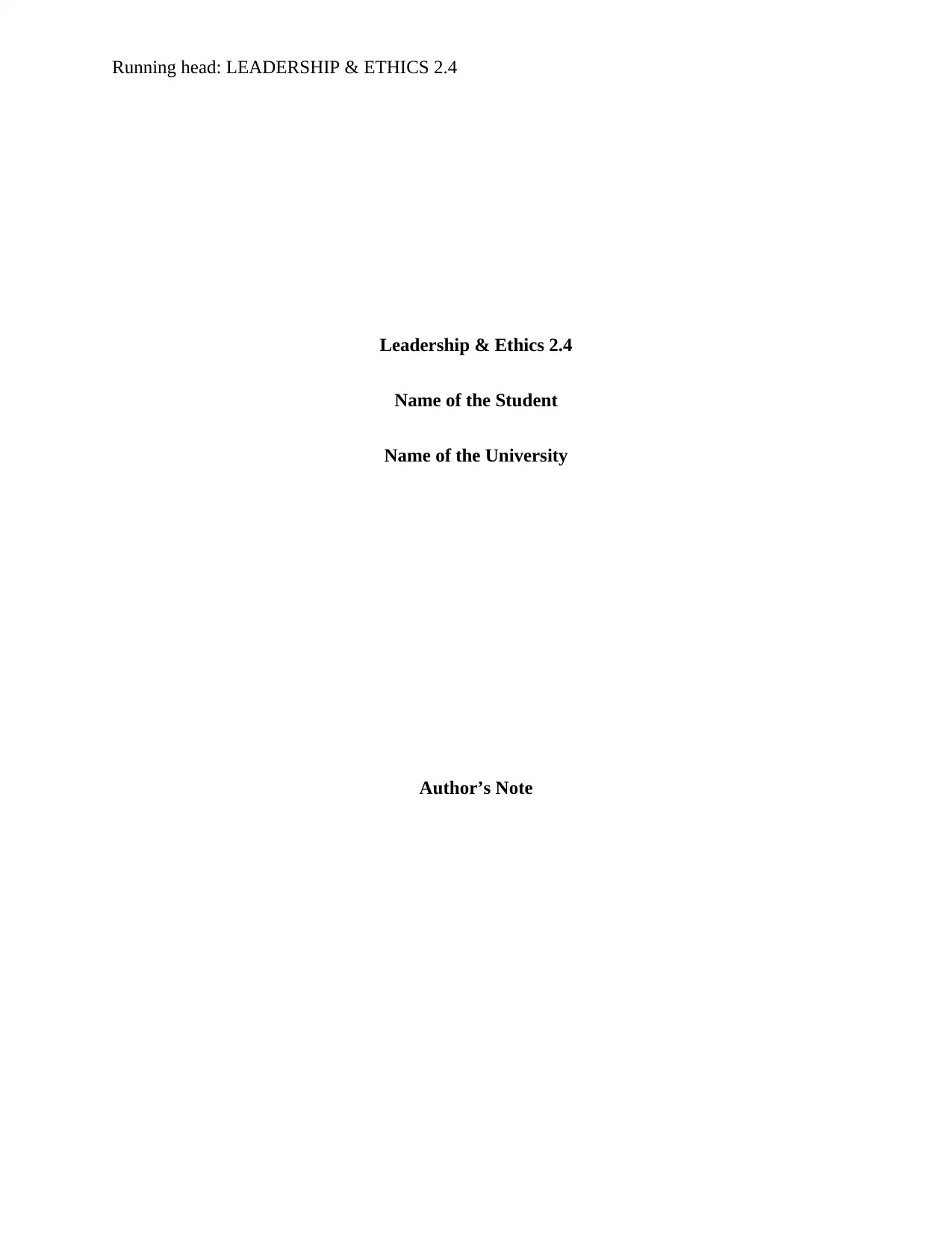
Running head: LEADERSHIP & ETHICS 2.4
Leadership & Ethics 2.4
Name of the Student
Name of the University
Author’s Note
Leadership & Ethics 2.4
Name of the Student
Name of the University
Author’s Note
Paraphrase This Document
Need a fresh take? Get an instant paraphrase of this document with our AI Paraphraser
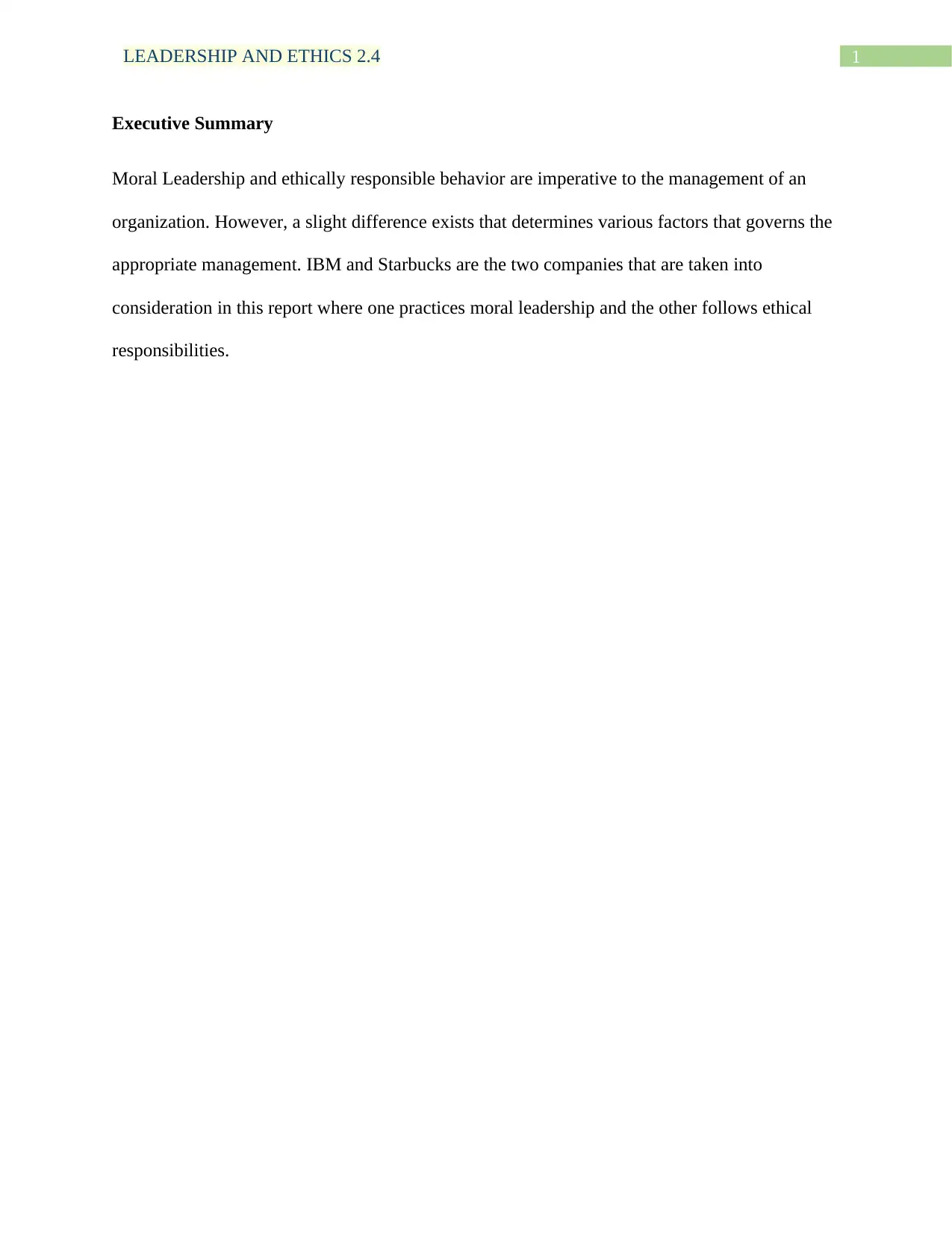
1LEADERSHIP AND ETHICS 2.4
Executive Summary
Moral Leadership and ethically responsible behavior are imperative to the management of an
organization. However, a slight difference exists that determines various factors that governs the
appropriate management. IBM and Starbucks are the two companies that are taken into
consideration in this report where one practices moral leadership and the other follows ethical
responsibilities.
Executive Summary
Moral Leadership and ethically responsible behavior are imperative to the management of an
organization. However, a slight difference exists that determines various factors that governs the
appropriate management. IBM and Starbucks are the two companies that are taken into
consideration in this report where one practices moral leadership and the other follows ethical
responsibilities.
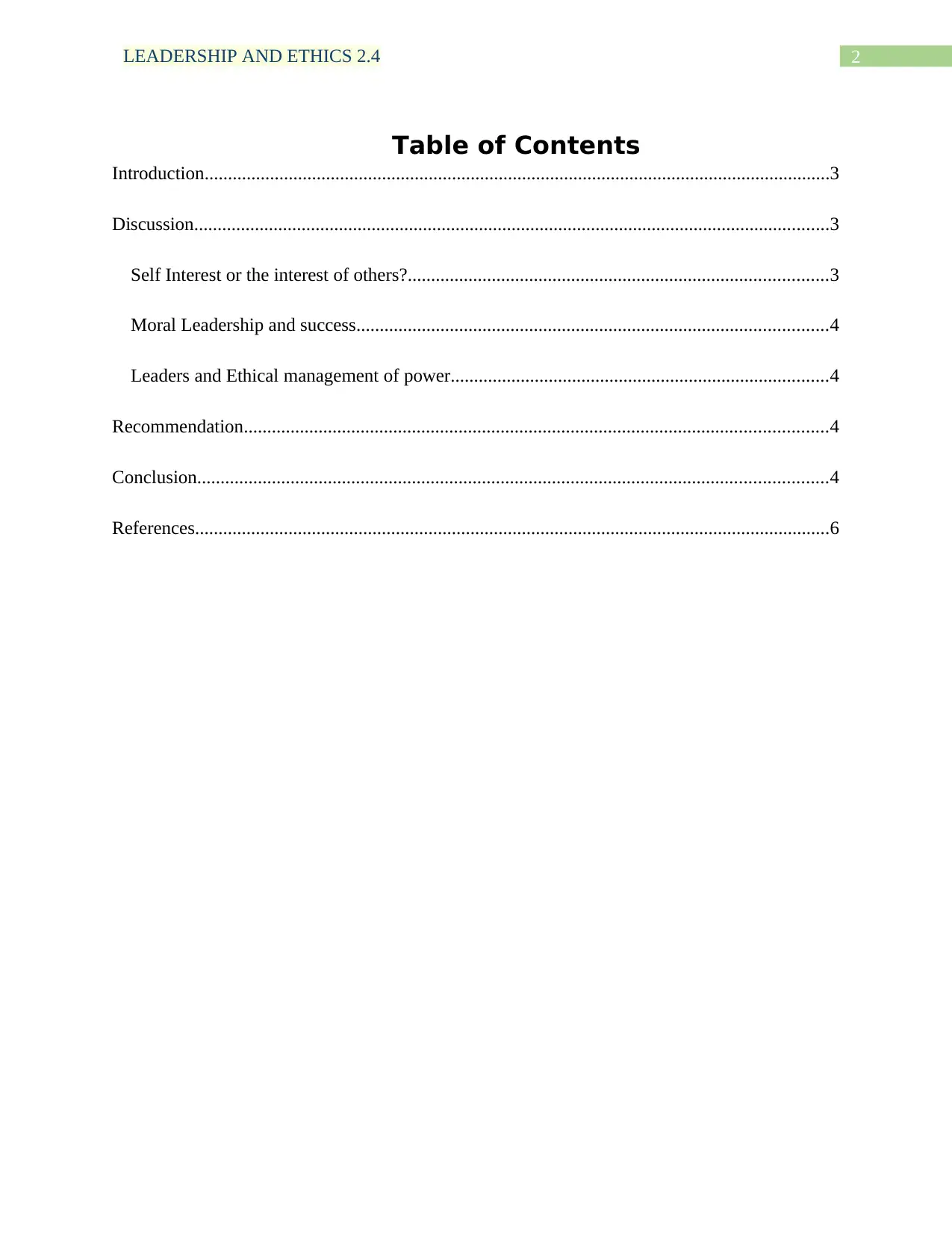
2LEADERSHIP AND ETHICS 2.4
Table of Contents
Introduction......................................................................................................................................3
Discussion........................................................................................................................................3
Self Interest or the interest of others?..........................................................................................3
Moral Leadership and success.....................................................................................................4
Leaders and Ethical management of power.................................................................................4
Recommendation.............................................................................................................................4
Conclusion.......................................................................................................................................4
References........................................................................................................................................6
Table of Contents
Introduction......................................................................................................................................3
Discussion........................................................................................................................................3
Self Interest or the interest of others?..........................................................................................3
Moral Leadership and success.....................................................................................................4
Leaders and Ethical management of power.................................................................................4
Recommendation.............................................................................................................................4
Conclusion.......................................................................................................................................4
References........................................................................................................................................6
⊘ This is a preview!⊘
Do you want full access?
Subscribe today to unlock all pages.

Trusted by 1+ million students worldwide
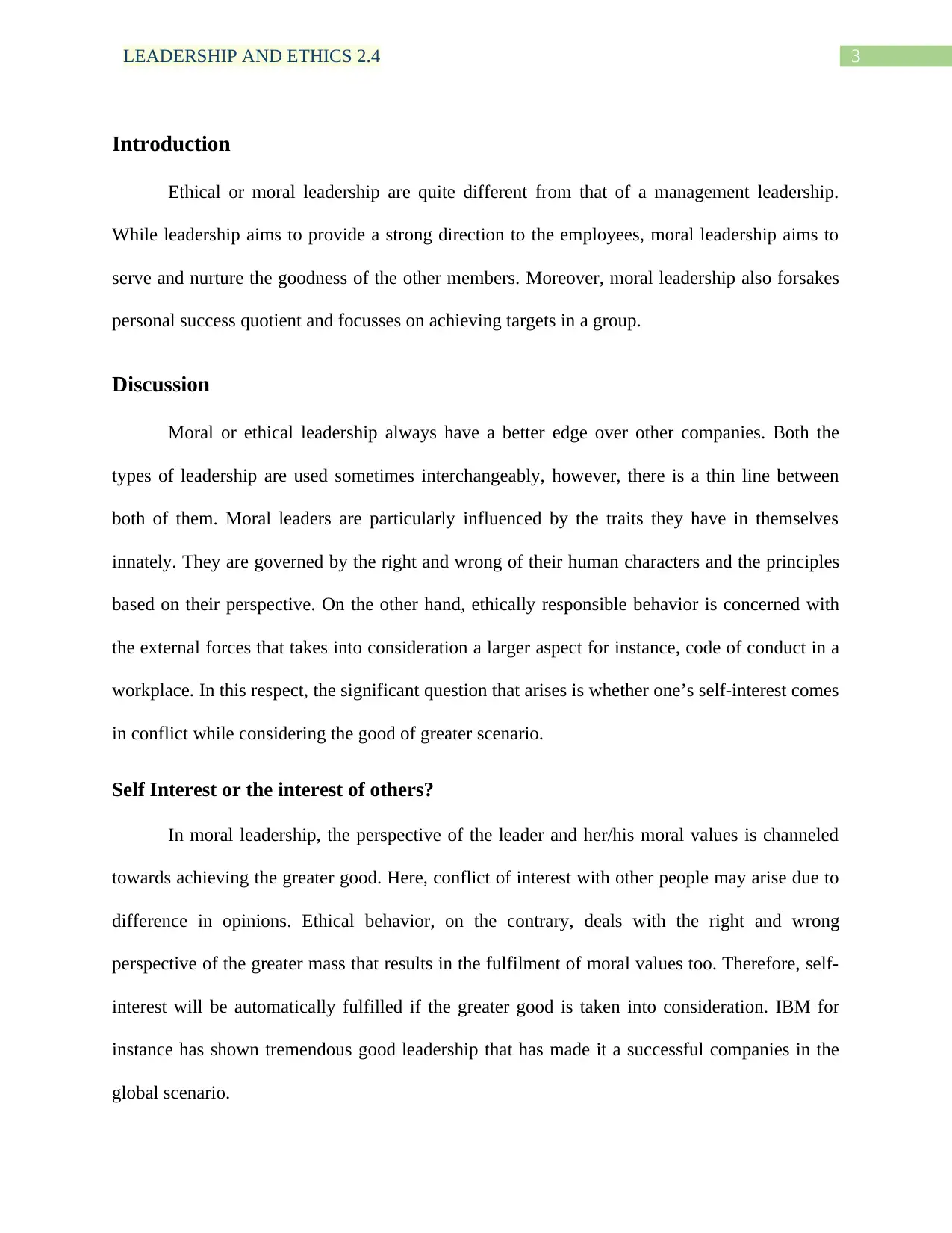
3LEADERSHIP AND ETHICS 2.4
Introduction
Ethical or moral leadership are quite different from that of a management leadership.
While leadership aims to provide a strong direction to the employees, moral leadership aims to
serve and nurture the goodness of the other members. Moreover, moral leadership also forsakes
personal success quotient and focusses on achieving targets in a group.
Discussion
Moral or ethical leadership always have a better edge over other companies. Both the
types of leadership are used sometimes interchangeably, however, there is a thin line between
both of them. Moral leaders are particularly influenced by the traits they have in themselves
innately. They are governed by the right and wrong of their human characters and the principles
based on their perspective. On the other hand, ethically responsible behavior is concerned with
the external forces that takes into consideration a larger aspect for instance, code of conduct in a
workplace. In this respect, the significant question that arises is whether one’s self-interest comes
in conflict while considering the good of greater scenario.
Self Interest or the interest of others?
In moral leadership, the perspective of the leader and her/his moral values is channeled
towards achieving the greater good. Here, conflict of interest with other people may arise due to
difference in opinions. Ethical behavior, on the contrary, deals with the right and wrong
perspective of the greater mass that results in the fulfilment of moral values too. Therefore, self-
interest will be automatically fulfilled if the greater good is taken into consideration. IBM for
instance has shown tremendous good leadership that has made it a successful companies in the
global scenario.
Introduction
Ethical or moral leadership are quite different from that of a management leadership.
While leadership aims to provide a strong direction to the employees, moral leadership aims to
serve and nurture the goodness of the other members. Moreover, moral leadership also forsakes
personal success quotient and focusses on achieving targets in a group.
Discussion
Moral or ethical leadership always have a better edge over other companies. Both the
types of leadership are used sometimes interchangeably, however, there is a thin line between
both of them. Moral leaders are particularly influenced by the traits they have in themselves
innately. They are governed by the right and wrong of their human characters and the principles
based on their perspective. On the other hand, ethically responsible behavior is concerned with
the external forces that takes into consideration a larger aspect for instance, code of conduct in a
workplace. In this respect, the significant question that arises is whether one’s self-interest comes
in conflict while considering the good of greater scenario.
Self Interest or the interest of others?
In moral leadership, the perspective of the leader and her/his moral values is channeled
towards achieving the greater good. Here, conflict of interest with other people may arise due to
difference in opinions. Ethical behavior, on the contrary, deals with the right and wrong
perspective of the greater mass that results in the fulfilment of moral values too. Therefore, self-
interest will be automatically fulfilled if the greater good is taken into consideration. IBM for
instance has shown tremendous good leadership that has made it a successful companies in the
global scenario.
Paraphrase This Document
Need a fresh take? Get an instant paraphrase of this document with our AI Paraphraser
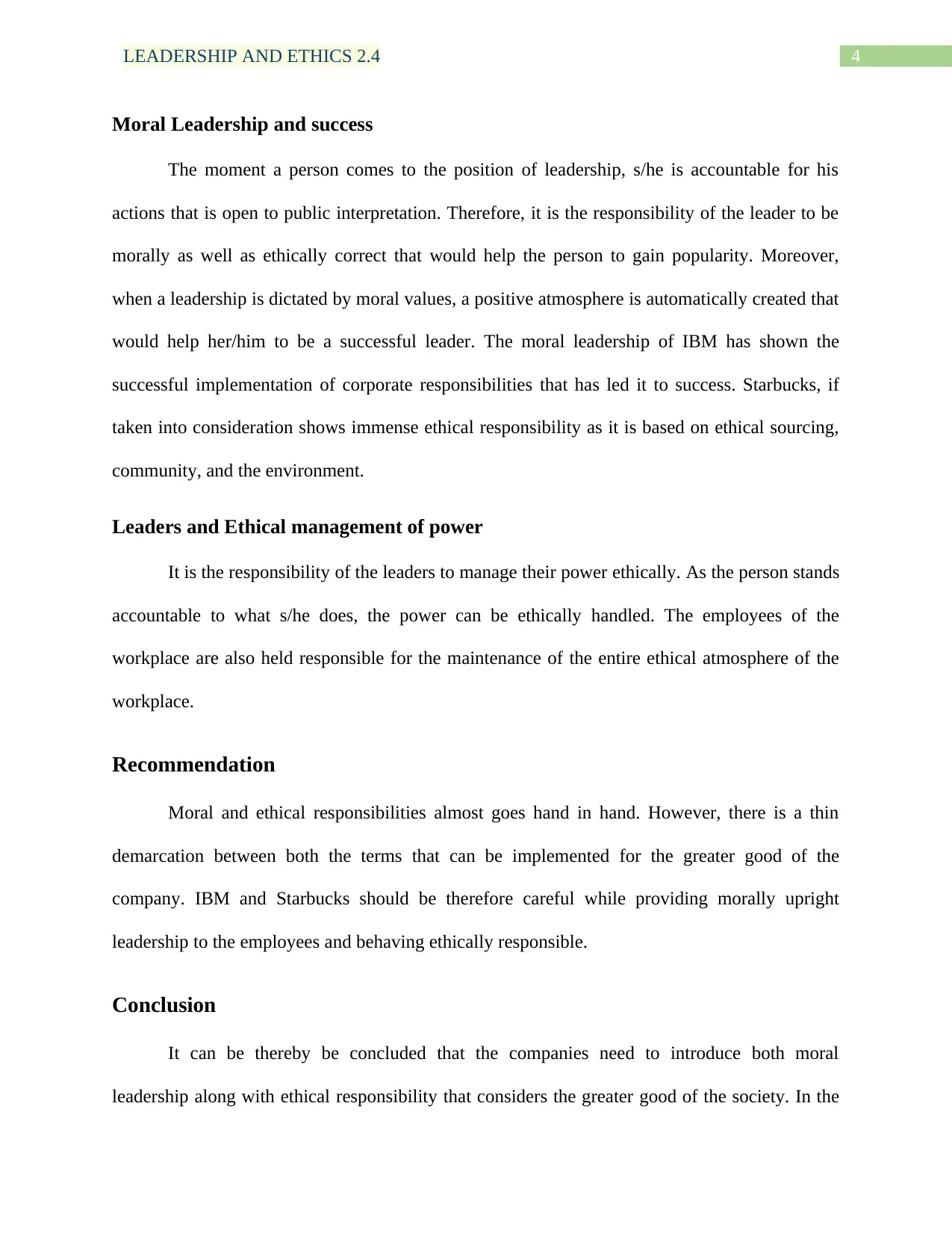
4LEADERSHIP AND ETHICS 2.4
Moral Leadership and success
The moment a person comes to the position of leadership, s/he is accountable for his
actions that is open to public interpretation. Therefore, it is the responsibility of the leader to be
morally as well as ethically correct that would help the person to gain popularity. Moreover,
when a leadership is dictated by moral values, a positive atmosphere is automatically created that
would help her/him to be a successful leader. The moral leadership of IBM has shown the
successful implementation of corporate responsibilities that has led it to success. Starbucks, if
taken into consideration shows immense ethical responsibility as it is based on ethical sourcing,
community, and the environment.
Leaders and Ethical management of power
It is the responsibility of the leaders to manage their power ethically. As the person stands
accountable to what s/he does, the power can be ethically handled. The employees of the
workplace are also held responsible for the maintenance of the entire ethical atmosphere of the
workplace.
Recommendation
Moral and ethical responsibilities almost goes hand in hand. However, there is a thin
demarcation between both the terms that can be implemented for the greater good of the
company. IBM and Starbucks should be therefore careful while providing morally upright
leadership to the employees and behaving ethically responsible.
Conclusion
It can be thereby be concluded that the companies need to introduce both moral
leadership along with ethical responsibility that considers the greater good of the society. In the
Moral Leadership and success
The moment a person comes to the position of leadership, s/he is accountable for his
actions that is open to public interpretation. Therefore, it is the responsibility of the leader to be
morally as well as ethically correct that would help the person to gain popularity. Moreover,
when a leadership is dictated by moral values, a positive atmosphere is automatically created that
would help her/him to be a successful leader. The moral leadership of IBM has shown the
successful implementation of corporate responsibilities that has led it to success. Starbucks, if
taken into consideration shows immense ethical responsibility as it is based on ethical sourcing,
community, and the environment.
Leaders and Ethical management of power
It is the responsibility of the leaders to manage their power ethically. As the person stands
accountable to what s/he does, the power can be ethically handled. The employees of the
workplace are also held responsible for the maintenance of the entire ethical atmosphere of the
workplace.
Recommendation
Moral and ethical responsibilities almost goes hand in hand. However, there is a thin
demarcation between both the terms that can be implemented for the greater good of the
company. IBM and Starbucks should be therefore careful while providing morally upright
leadership to the employees and behaving ethically responsible.
Conclusion
It can be thereby be concluded that the companies need to introduce both moral
leadership along with ethical responsibility that considers the greater good of the society. In the
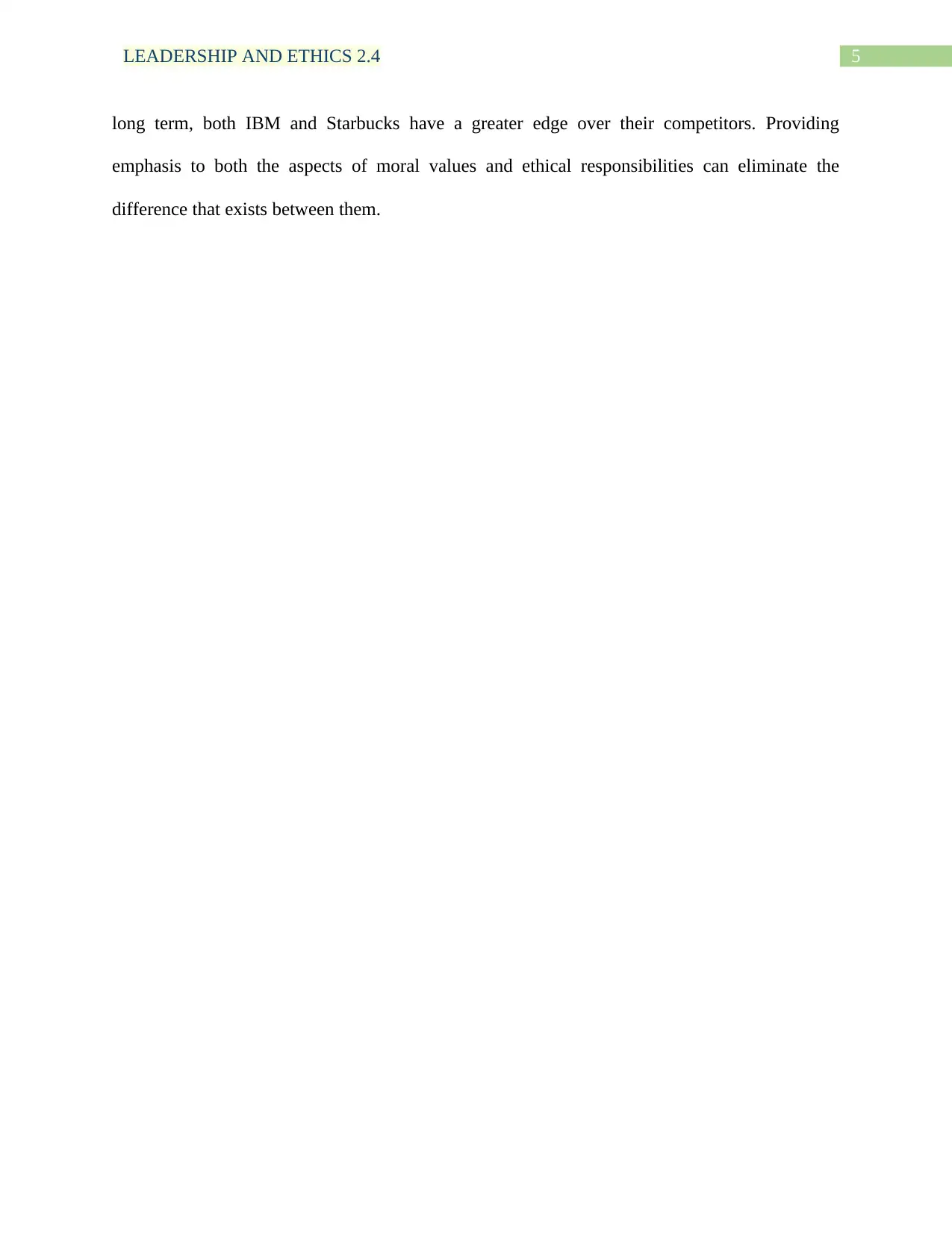
5LEADERSHIP AND ETHICS 2.4
long term, both IBM and Starbucks have a greater edge over their competitors. Providing
emphasis to both the aspects of moral values and ethical responsibilities can eliminate the
difference that exists between them.
long term, both IBM and Starbucks have a greater edge over their competitors. Providing
emphasis to both the aspects of moral values and ethical responsibilities can eliminate the
difference that exists between them.
⊘ This is a preview!⊘
Do you want full access?
Subscribe today to unlock all pages.

Trusted by 1+ million students worldwide
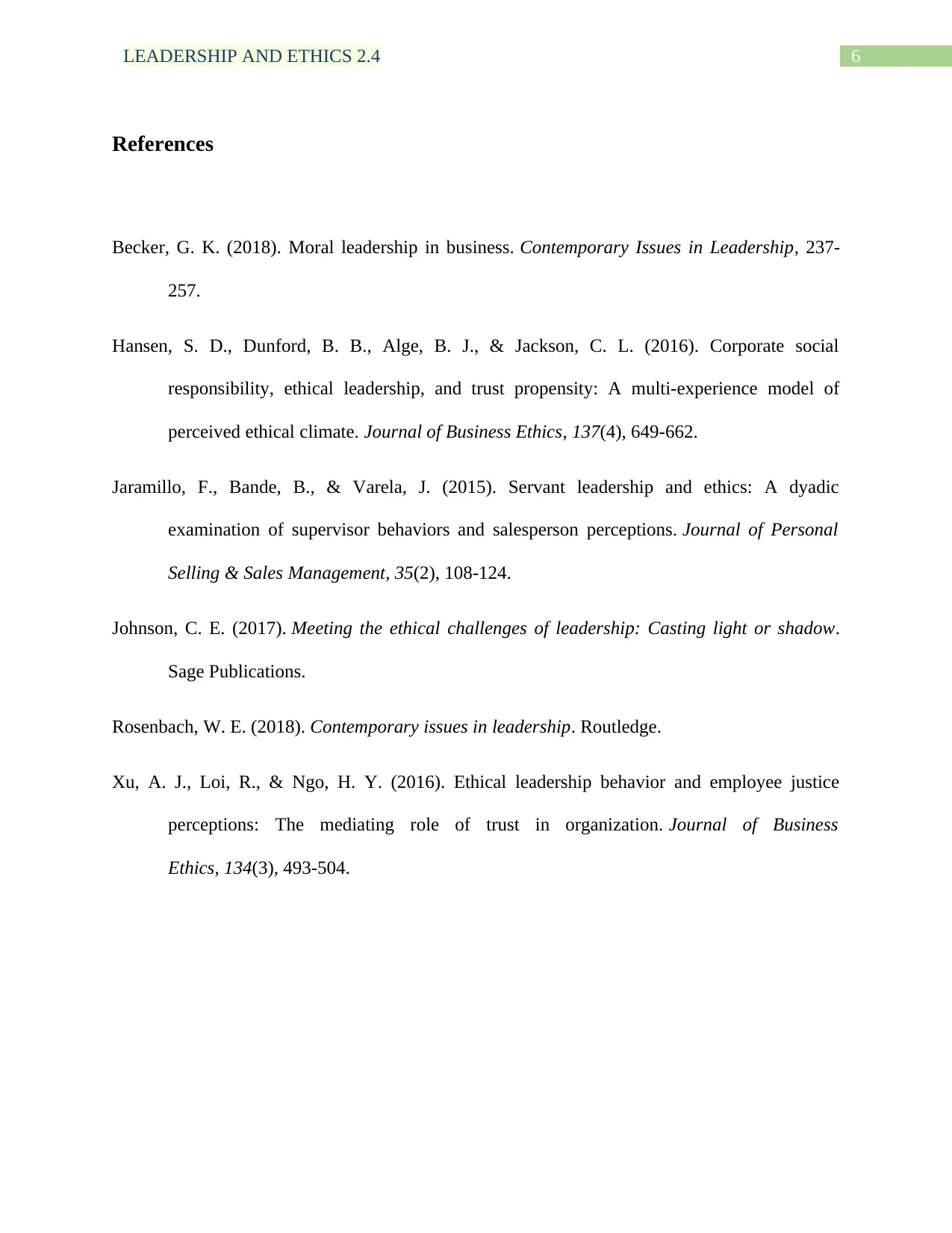
6LEADERSHIP AND ETHICS 2.4
References
Becker, G. K. (2018). Moral leadership in business. Contemporary Issues in Leadership, 237-
257.
Hansen, S. D., Dunford, B. B., Alge, B. J., & Jackson, C. L. (2016). Corporate social
responsibility, ethical leadership, and trust propensity: A multi-experience model of
perceived ethical climate. Journal of Business Ethics, 137(4), 649-662.
Jaramillo, F., Bande, B., & Varela, J. (2015). Servant leadership and ethics: A dyadic
examination of supervisor behaviors and salesperson perceptions. Journal of Personal
Selling & Sales Management, 35(2), 108-124.
Johnson, C. E. (2017). Meeting the ethical challenges of leadership: Casting light or shadow.
Sage Publications.
Rosenbach, W. E. (2018). Contemporary issues in leadership. Routledge.
Xu, A. J., Loi, R., & Ngo, H. Y. (2016). Ethical leadership behavior and employee justice
perceptions: The mediating role of trust in organization. Journal of Business
Ethics, 134(3), 493-504.
References
Becker, G. K. (2018). Moral leadership in business. Contemporary Issues in Leadership, 237-
257.
Hansen, S. D., Dunford, B. B., Alge, B. J., & Jackson, C. L. (2016). Corporate social
responsibility, ethical leadership, and trust propensity: A multi-experience model of
perceived ethical climate. Journal of Business Ethics, 137(4), 649-662.
Jaramillo, F., Bande, B., & Varela, J. (2015). Servant leadership and ethics: A dyadic
examination of supervisor behaviors and salesperson perceptions. Journal of Personal
Selling & Sales Management, 35(2), 108-124.
Johnson, C. E. (2017). Meeting the ethical challenges of leadership: Casting light or shadow.
Sage Publications.
Rosenbach, W. E. (2018). Contemporary issues in leadership. Routledge.
Xu, A. J., Loi, R., & Ngo, H. Y. (2016). Ethical leadership behavior and employee justice
perceptions: The mediating role of trust in organization. Journal of Business
Ethics, 134(3), 493-504.
1 out of 7
Related Documents
Your All-in-One AI-Powered Toolkit for Academic Success.
+13062052269
info@desklib.com
Available 24*7 on WhatsApp / Email
![[object Object]](/_next/static/media/star-bottom.7253800d.svg)
Unlock your academic potential
Copyright © 2020–2025 A2Z Services. All Rights Reserved. Developed and managed by ZUCOL.





